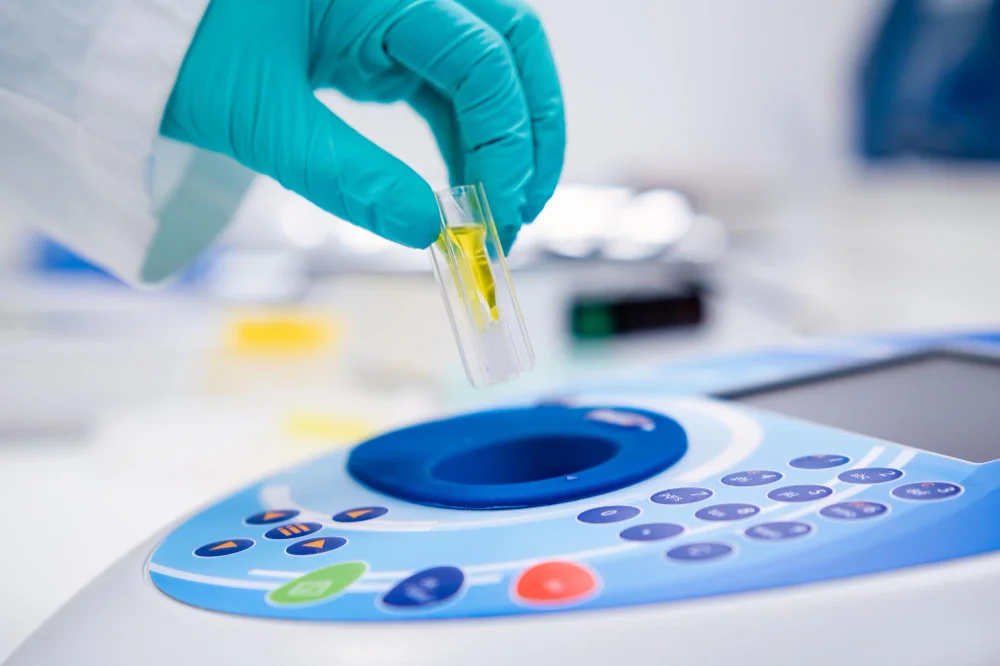Spectroscopy has been a cornerstone of scientific research for centuries. The instruments and devices used to perform spectroscopic analysis have revolutionized technology and impacted various disciplines in the scientific field, from physics and chemistry to astronomy and medicine.
Exploring spectroscopy has been an influential scientific technique because it has enabled researchers to uncover fundamental principles and make significant discoveries by analyzing the interaction of light with matter. This technology provides invaluable insights into materials’ composition, structure, and properties.
Fundamentals of Spectroscopy
The fundamental principle is based on the fact that different elements and compounds absorb, emit, or scatter light at specific wavelengths, leading to distinct spectral signatures. Scientists can gather information about substances’ chemical composition, molecular structure, and physical properties by studying these signatures.
Spectroscopy analyzes various regions of the electromagnetic spectrum, including ultraviolet (UV), visible, infrared (IR), microwave, and radio frequencies. Here are some common spectroscopy tools used in scientific research and analysis:
Spectrophotometer
A spectrophotometer analyzes light’s absorption, transmission, or reflection at specific wavelengths by measuring light intensity after it passes through a sample to determine the concentration of substances. Spectrophotometers are widely used in chemical analysis, biochemistry, environmental science, and pharmaceutical research.
For a spectrophotometer to function, it should include a light source, a monochromator or wavelength selector, a sample holder or cuvette, and a detector. The light source emits a broad spectrum of light, typically ranging from ultraviolet (UV) to visible (VIS) or near-infrared (NIR) wavelengths.
Mass Spectrometer
A mass spectrometer is an analytical tool that provides information about a sample’s molecular composition, structure, and abundance of compounds. Mass spectrometry is widely utilized in numerous fields, including chemistry, biochemistry, forensic science, environmental science, and pharmaceutical research.
In addition, a mass spectrometer needs an ionization source, a mass analyzer, and a detector to work. The process begins with the ionization of sample molecules, where the ionization source converts the analyte molecules into ions by adding or removing electrons.
Different ionization methods are matrix-assisted laser desorption or ionization, electrospray ionization, and electron ionization. The ions generated using a mass analyzer from the sample are then accelerated and separated based on their mass-to-charge ratio.
Various mass analyzers are employed in different mass spectrometry instruments, such as quadrupole, time-of-flight, ion trap, and magnetic sector analyzers. Each type of analyzer has its advantages and is suited for specific applications.
Nuclear Magnetic Resonance Spectrometer
A Nuclear Magnetic Resonance Spectrometer is used to study the structure and properties of molecules by analyzing their nuclear magnetic resonance behavior. This methodological technique provides detailed information about the chemical environment, connectivity, and dynamics of atoms within a molecule.
NMR spectrometers include a powerful magnet, a radio frequency transmitter and receiver, and a computer system for data acquisition and analysis. This technique is mostly used in chemistry, biochemistry, and medicine for structural elucidation and compound identification.
Infrared Spectrometer
An infrared spectrometer is used to examine the interaction of infrared radiation with matter. Infrared spectroscopy is a systematic technique that provides information about a sample’s molecular composition, structure, and bonding.
Also, the infrared spectrometer is widely utilized in various fields, including chemistry, biochemistry, pharmaceuticals, materials science, and environmental science.
IR spectrometer comprises a radiation source, an optical system, a sample holder or cell, and a detector. The radiation source typically emits a broadband infrared spectrum, covering a range of wavelengths. Common sources include a globar, a heated silicon carbide rod, and a Fourier transform infrared (FTIR) spectrometer.
Ultraviolet-Visible (UV-Vis) Spectrophotometer
UV-Vis spectrophotometers are commonly used to quantify the concentration of analytes in solutions and study the electronic transitions of molecules. Additionally, UV-Vis spectroscopy finds applications in pharmaceutical analysis, environmental monitoring, and biochemical research.
UV-VIS spectroscopy is a powerful analytical technique, and Agilent UV VIS spectroscopy systems from Agilent Technologies have gained significant popularity and recognition. The Agilent UV-Vis spectroscope is designed to deliver accurate and reliable results while offering versatility and ease of use through its user-friendly software.
These instruments are equipped with advanced features that enhance their performance and capabilities. Also, UV-Vis spectroscopy offers various measurement modes, including absorbance, transmittance, and reflectance.
Raman Spectrometer
Raman spectrometers measure the Raman scattering of light, which occurs when photons interact with molecular vibrations and rotations. This technique gives information about molecular structures, crystallography, and chemical identification in diverse fields such as pharmaceuticals, forensics, geology, and materials science.
In addition, Raman spectrometers have a laser source, an optical system, a sample holder or probe, and a detector. The laser source emits a monochromatic laser beam, typically in the visible or near-infrared range, which is directed onto the sample. Consequently, the laser light’s interaction with the sample causes the photons to scatter.
X-ray Spectrometer
X-ray spectrometers can determine samples’ elemental composition, crystal structures, and phase information by analyzing the characteristic X-ray emissions or diffraction patterns produced when X-rays interact with matter.
Also, X-ray spectrometers contain an X-ray source, a detector, and an analysis system. This technique is employed in materials science, geology, archaeology, and medical imaging.
Applications in Chemistry and Materials Science
Techniques such as nuclear magnetic resonance (NMR) spectroscopy and infrared spectroscopy allow chemists to determine the structure and connectivity of molecules. This information is crucial for drug discovery, environmental analysis, and developing new materials.
Spectroscopic techniques are also used in materials science to investigate the properties of solids, liquids, and gases, enabling researchers to tailor materials for specific applications. For example, X-ray spectroscopy provides insights into the electronic structure of materials, aiding the design of more efficient solar cells and catalysts.
Advancements in Astronomy
Studying celestial objects’ spectra provides valuable information about their composition, temperature, and motion. Astronomers employ optical and radio spectroscopy to analyze the light emitted or absorbed by stars, galaxies, and interstellar matter.
Spectroscopic observations have led to groundbreaking discoveries, such as identifying elements in distant stars and detecting exoplanets by measuring their radial velocity. The redshift phenomenon observed in the spectra of distant galaxies has provided evidence for the expansion of the universe and the Big Bang theory.
Medical and Biological Applications
In medical diagnostics, magnetic resonance spectroscopy and positron emission tomography employ spectroscopic principles to study the human body’s biochemical composition and metabolic processes.
MRS enables the non-invasive measurement of various metabolites, aiding in diagnosing and monitoring diseases such as cancer and neurological disorders. Similarly, PET imaging uses radiotracers that emit gamma rays, which can be detected and analyzed to visualize physiological processes and identify abnormalities.
The Future of Spectroscopy
With more sensitive detectors and faster data processing techniques, spectroscopy will become more accessible and enable high-throughput analysis, allowing for the rapid screening of large sample sets. This technology will affect drug discovery, environmental monitoring, and quality control.
Researchers are also exploring novel spectroscopic methods. One example is terahertz spectroscopy, which operates in the frequency range between microwaves and infrared radiation.
Terahertz spectroscopy has the potential to reveal unique molecular fingerprints and provide insights into materials that are challenging to analyze using conventional techniques. Scientists can use this technique for pharmaceutical applications, security screening, and art conservation applications.
Spectroscopy has also been increasingly utilized in environmental science and sustainability. By studying the spectral characteristics of atmospheric gases, scientists can monitor and measure pollutant levels, aiding in assessing air quality and the impact of human activities on the environment.


















